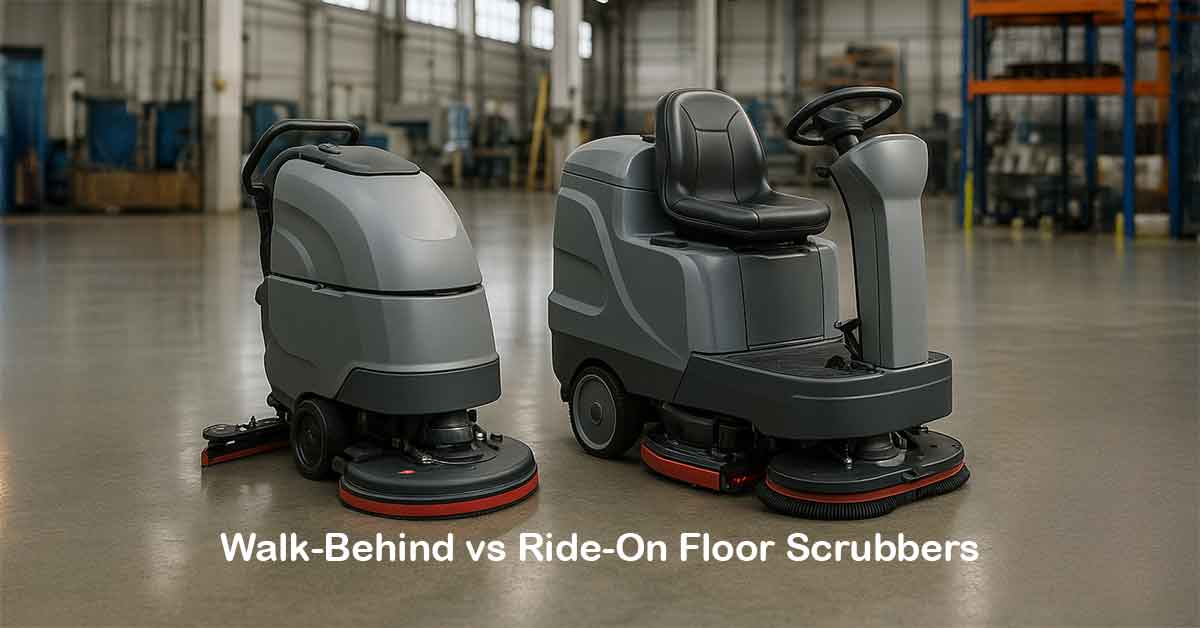
Walk-Behind vs Ride-On Floor Scrubbers: Which Is Right for Your Facility?
Keeping floors clean in large facilities is about more than appearancesm it’s about safety, efficiency, and reducing long-term labor costs. Slips, trips, and inefficient cleaning can directly impact staff productivity, customer experience, and even liability risks.
Two of the most widely used solutions are walk-behind floor scrubbers and ride-on floor scrubbers. Both offer significant improvements over traditional mop-and-bucket cleaning, but they differ in cost, coverage, and suitability depending on the type of building you manage.
This guide breaks down the differences, with real-world examples and expert insights, so you can choose the right option for your facility.
Quick Comparison: Walk-Behind vs. Ride-On Scrubbers
| Feature | Walk-Behind Scrubbers | Ride-On Scrubbers |
|---|---|---|
| Cleaning Path | 17–28 inches | 28–45 inches |
| Ideal For | Schools, gyms, small to mid-size facilities | Warehouses, hospitals, airports, stadiums |
| Price Range | $2,500–$7,500 | $8,000–$20,000+ |
| Staff Training | Minimal | Moderate (controls + safety) |
| Storage Needs | Compact, easy to store | Requires larger storage space |
| Productivity | 10,000–30,000 sq. ft./hr. | 30,000–75,000+ sq. ft./hr. |
Walk-Behind Floor Scrubbers
Walk-behind scrubbers are pushed or guided by an operator. They’re compact, versatile, and cost-effective, making them the most common choice for schools, gyms, and retail facilities.
Advantages
-
Lower upfront cost than ride-ons
-
Compact and maneuverable, ideal for classrooms, hallways, or retail aisles
-
Minimal training required for staff
-
Easy storage in janitorial closets or small equipment rooms
Limitations
-
Slower for large facilities (50,000+ sq. ft.)
-
Higher labor hours in expansive buildings
-
Operator fatigue during long cleaning sessions
Best Uses
-
Schools & universities
-
Fitness centers & gyms
-
Grocery stores & retail shops
-
Small to mid-size warehouses
Example Models: Tornado BR 18/11 or Tornado BR 28/27 are well-reviewed for their balance of productivity and affordability.
Ride-On Floor Scrubbers
Ride-on scrubbers allow operators to sit and drive, similar to a small vehicle. These machines are engineered for productivity, capable of cleaning massive spaces quickly.
Advantages
-
High productivity (up to 75,000 sq. ft./hr.)
-
Reduced operator fatigue with seated operation
-
Larger tanks = fewer solution refills
-
Ideal for labor savings in expansive facilities
Limitations
-
Higher upfront cost
-
Requires training for safe maneuvering
-
Not suitable for small or crowded spaces
-
Larger storage footprint
Best Uses
-
Airports & transportation hubs
-
Hospitals & healthcare facilities
-
Stadiums & arenas
-
Distribution centers & warehouses
Example Models: Tennant T16 and Nilfisk Advance ride-on scrubbers are widely used in large-scale facilities.
Key Comparison Factors
1. Cost of Ownership
-
Walk-behind: Lower upfront and maintenance costs.
-
Ride-on: Higher initial investment but long-term labor savings.
2. Productivity & Coverage
-
Walk-behind: 10,000–30,000 sq. ft./hr.
-
Ride-on: 30,000–75,000+ sq. ft./hr.
3. Training & Safety
-
Walk-behind: Simple controls, plug-and-play.
-
Ride-on: Requires instruction for safety and efficient operation.
4. Maintenance & Storage
-
Walk-behind: Compact, easier to maintain.
-
Ride-on: Requires more storage space, higher service costs.
Frequently Asked Questions (FAQs)
Do I need a license to operate a ride-on scrubber?
No license is required, but staff should receive in-house training on controls, safety, and best practices.
How long do scrubber batteries last?
Most batteries last 3–5 years with routine maintenance. Runtime is typically 2–4 hours per charge, depending on the model.
What’s the average lifespan of a floor scrubber?
With proper maintenance, most machines last 7–10 years, though commercial ride-on units may last longer with professional servicing.
Conclusion: Which One Should You Choose?
-
-
Choose a walk-behind scrubber if your facility is under 50,000 sq. ft. and requires maneuverability in classrooms, gym floors, or retail aisles.
-
Choose a ride-on scrubber if you manage large spaces like airports, hospitals, or warehouses where speed and labor efficiency justify the higher upfront price.
-
👉 At ScrubUSA, we currently carry a range of Tornado walk-behind scrubbers that balance performance and cost. [Browse Tornado walk-behind scrubbers here].

